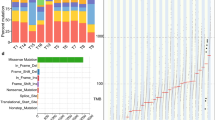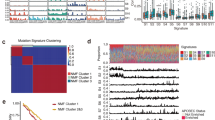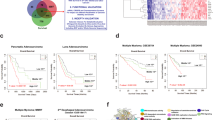Abstract
The incidence of esophageal adenocarcinoma (EAC) has risen 600% over the last 30 years. With a 5-year survival rate of ∼15%, the identification of new therapeutic targets for EAC is greatly important. We analyze the mutation spectra from whole-exome sequencing of 149 EAC tumor-normal pairs, 15 of which have also been subjected to whole-genome sequencing. We identify a mutational signature defined by a high prevalence of A>C transversions at AA dinucleotides. Statistical analysis of exome data identified 26 significantly mutated genes. Of these genes, five (TP53, CDKN2A, SMAD4, ARID1A and PIK3CA) have previously been implicated in EAC. The new significantly mutated genes include chromatin-modifying factors and candidate contributors SPG20, TLR4, ELMO1 and DOCK2. Functional analyses of EAC-derived mutations in ELMO1 identifies increased cellular invasion. Therefore, we suggest the potential activation of the RAC1 pathway as a contributor to EAC tumorigenesis.
This is a preview of subscription content, access via your institution
Access options
Subscribe to this journal
Receive 12 print issues and online access
$209.00 per year
only $17.42 per issue
Buy this article
- Purchase on SpringerLink
- Instant access to full article PDF
Prices may be subject to local taxes which are calculated during checkout





Similar content being viewed by others
Accession codes
References
Holmes, R.S. & Vaughan, T.L. Epidemiology and pathogenesis of esophageal cancer. Semin. Radiat. Oncol. 17, 2–9 (2007).
Pohl, H. & Welch, H.G. The role of overdiagnosis and reclassification in the marked increase of esophageal adenocarcinoma incidence. J. Natl. Cancer Inst. 97, 142–146 (2005).
Wu, A.H., Wan, P. & Bernstein, L. A multiethnic population-based study of smoking, alcohol and body size and risk of adenocarcinomas of the stomach and esophagus (United States). Cancer Causes Control 12, 721–732 (2001).
Chung, S.M., Kao, J., Hyjek, E. & Chen, Y.T. p53 in esophageal adenocarcinoma: a critical reassessment of mutation frequency and identification of 72Arg as the dominant allele. Int. J. Oncol. 31, 1351–1355 (2007).
Hardie, L.J. et al. p16 expression in Barrett's esophagus and esophageal adenocarcinoma: association with genetic and epigenetic alterations. Cancer Lett. 217, 221–230 (2005).
Choi, Y.W., Heath, E.I., Heitmiller, R., Forastiere, A.A. & Wu, T.T. Mutations in β-catenin and APC genes are uncommon in esophageal and esophagogastric junction adenocarcinomas. Mod. Pathol. 13, 1055–1059 (2000).
Sommerer, F. et al. Mutations of BRAF and KRAS2 in the development of Barrett's adenocarcinoma. Oncogene 23, 554–558 (2004).
Wijnhoven, B.P., de Both, N.J., van Dekken, H., Tilanus, H.W. & Dinjens, W.N. E-cadherin gene mutations are rare in adenocarcinomas of the oesophagus. Br. J. Cancer 80, 1652–1657 (1999).
Pühringer-Oppermann, F.A., Stein, H.J. & Sarbia, M. Lack of EGFR gene mutations in exons 19 and 21 in esophageal (Barrett's) adenocarcinomas. Dis. Esophagus 20, 9–11 (2007).
Guo, M., Liu, S. & Lu, F. Gefitinib-sensitizing mutations in esophageal carcinoma. N. Engl. J. Med. 354, 2193–2194 (2006).
Phillips, W.A. et al. Mutation analysis of PIK3CA and PIK3CB in esophageal cancer and Barrett's esophagus. Int. J. Cancer 118, 2644–2646 (2006).
Boonstra, J.J. et al. Mapping of homozygous deletions in verified esophageal adenocarcinoma cell lines and xenografts. Genes Chromosom. Cancer 51, 272–282 (2012).
Agrawal, N. et al. Comparative genomic analysis of esophageal adenocarcinoma and squamous cell carcinoma. Cancer Discov. 2, 899–905 (2012).
Cancer Genome Atlas Research Network. Integrated genomic analyses of ovarian carcinoma. Nature 474, 609–615 (2011).
Berger, M.F. et al. The genomic complexity of primary human prostate cancer. Nature 470, 214–220 (2011).
Chapman, M.A. et al. Initial genome sequencing and analysis of multiple myeloma. Nature 471, 467–472 (2011).
Cibulskis, K. et al. Sensitive detection of somatic point mutations in impure and heterogeneous cancer samples. Nat. Biotechnol. 31, 213–219 (2013).
Imielinski, M. et al. Mapping the hallmarks of lung adenocarcinoma with massively parallel sequencing. Cell 150, 1107–1120 (2012).
Cancer Genome Atlas Research Network. Comprehensive genomic characterization of squamous cell lung cancers. Nature 489, 519–525 (2012).
Berger, M.F. et al. Melanoma genome sequencing reveals frequent PREX2 mutations. Nature 485, 502–506 (2012).
Bass, A.J. et al. Genomic sequencing of colorectal adenocarcinomas identifies a recurrent VTI1A-TCF7L2 fusion. Nat. Genet. 43, 964–968 (2011).
Orlando, R.C. Mucosal defense in Barrett's esophagus. in Barrett's Esophagus and Esophageal Adenocarcinoma (ed. Sharma, P.) 60–72 (Blackwell Publishing, Oxford, 2006).
Dulak, A.M. et al. Gastrointestinal adenocarcinomas of the esophagus, stomach and colon exhibit distinct patterns of genome instability and oncogenesis. Cancer Res. 72, 4383–4393 (2012).
Cancer Genome Atlas Network. Comprehensive molecular characterization of human colon and rectal cancer. Nature 487, 330–337 (2012).
Banerji, S . et al. Sequence analysis of mutations and translocations across breast cancer subtypes. Nature 486, 405–409 (2012).
Barbieri, C.E. et al. Exome sequencing identifies recurrent SPOP, FOXA1 and MED12 mutations in prostate cancer. Nat. Genet. 44, 685–689 (2012).
Farris, A.B. III et al. Clinicopathologic and molecular profiles of microsatellite unstable Barrett esophagus–associated adenocarcinoma. Am. J. Surg. Pathol. 35, 647–655 (2011).
Sanui, T. et al. DOCK2 regulates Rac activation and cytoskeletal reorganization through interaction with ELMO1. Blood 102, 2948–2950 (2003).
Hanawa-Suetsugu, K. et al. Structural basis for mutual relief of the Rac guanine nucleotide exchange factor DOCK2 and its partner ELMO1 from their autoinhibited forms. Proc. Natl. Acad. Sci. USA 109, 3305–3310 (2012).
Gómez del Pulgar, T., Benitah, S.A., Valeron, P.F., Espina, C. & Lacal, J.C. Rho GTPase expression in tumourigenesis: evidence for a significant link. Bioessays 27, 602–613 (2005).
Hodis, E. et al. A landscape of driver mutations in melanoma. Cell 150, 251–263 (2012).
Kissil, J.L. et al. Requirement for Rac1 in a K-ras–induced lung cancer in the mouse. Cancer Res. 67, 8089–8094 (2007).
Pan, Y. et al. Expression of seven main Rho family members in gastric carcinoma. Biochem. Biophys. Res. Commun. 315, 686–691 (2004).
Sander, E.E. et al. Matrix-dependent Tiam1/Rac signaling in epithelial cells promotes either cell-cell adhesion or cell migration and is regulated by phosphatidylinositol 3-kinase. J. Cell Biol. 143, 1385–1398 (1998).
Nishihara, H. et al. Non-adherent cell–specific expression of DOCK2, a member of the human CDM-family proteins. Biochim. Biophys. Acta 1452, 179–187 (1999).
Sanz-Moreno, V. et al. Rac activation and inactivation control plasticity of tumor cell movement. Cell 135, 510–523 (2008).
Jarzynka, M.J. et al. ELMO1 and Dock180, a bipartite Rac1 guanine nucleotide exchange factor, promote human glioma cell invasion. Cancer Res. 67, 7203–7211 (2007).
Shrestha, Y. et al. PAK1 is a breast cancer oncogene that coordinately activates MAPK and MET signaling. Oncogene 31, 3397–3408 (2012).
Medina, P.P. et al. Frequent BRG1/SMARCA4-inactivating mutations in human lung cancer cell lines. Hum. Mutat. 29, 617–622 (2008).
Zang, Z.J. et al. Exome sequencing of gastric adenocarcinoma identifies recurrent somatic mutations in cell adhesion and chromatin remodeling genes. Nat. Genet. 44, 570–574 (2012).
Fujimoto, A. et al. Whole-genome sequencing of liver cancers identifies etiological influences on mutation patterns and recurrent mutations in chromatin regulators. Nat. Genet. 44, 760–764 (2012).
Jones, S. et al. Somatic mutations in the chromatin remodeling gene ARID1A occur in several tumor types. Hum. Mutat. 33, 100–103 (2012).
Guan, B., Wang, T.L. & Shih Ie, M. ARID1A, a factor that promotes formation of SWI/SNF-mediated chromatin remodeling, is a tumor suppressor in gynecologic cancers. Cancer Res. 71, 6718–6727 (2011).
Varela, I. et al. Exome sequencing identifies frequent mutation of the SWI/SNF complex gene PBRM1 in renal carcinoma. Nature 469, 539–542 (2011).
Patel, H. et al. SPG20 is mutated in Troyer syndrome, an hereditary spastic paraplegia. Nat. Genet. 31, 347–348 (2002).
Bakowska, J.C., Jupille, H., Fatheddin, P., Puertollano, R. & Blackstone, C. Troyer syndrome protein spartin is mono-ubiquitinated and functions in EGF receptor trafficking. Mol. Biol. Cell 18, 1683–1692 (2007).
Lind, G.E. et al. SPG20, a novel biomarker for early detection of colorectal cancer, encodes a regulator of cytokinesis. Oncogene 30, 3967–3978 (2011).
Garza-Gonzalez, E. et al. Assessment of the toll-like receptor 4 Asp299Gly, Thr399Ile and interleukin-8-251 polymorphisms in the risk for the development of distal gastric cancer. BMC Cancer 7, 70 (2007).
Bauer, A.K. et al. Toll-like receptor 4 in butylated hydroxytoluene–induced mouse pulmonary inflammation and tumorigenesis. J. Natl. Cancer Inst. 97, 1778–1781 (2005).
Kennedy, M.N. et al. A complex of soluble MD-2 and lipopolysaccharide serves as an activating ligand for Toll-like receptor 4. J. Biol. Chem. 279, 34698–34704 (2004).
Park, B.S. et al. The structural basis of lipopolysaccharide recognition by the TLR4–MD-2 complex. Nature 458, 1191–1195 (2009).
Schreiner, A. et al. Junction protein shrew-1 influences cell invasion and interacts with invasion-promoting protein CD147. Mol. Biol. Cell 18, 1272–1281 (2007).
Liu, L. et al. Deregulated MYC expression induces dependence upon AMPK-related kinase 5. Nature 483, 608–612 (2012).
Pelletier, N., Champagne, N., Stifani, S. & Yang, X.J. MOZ and MORF histone acetyltransferases interact with the Runt-domain transcription factor Runx2. Oncogene 21, 2729–2740 (2002).
Forbes, S.A. et al. COSMIC: mining complete cancer genomes in the Catalogue of Somatic Mutations in Cancer. Nucleic Acids Res. 39, D945–D950 (2011).
Garnett, M.J. et al. Systematic identification of genomic markers of drug sensitivity in cancer cells. Nature 483, 570–575 (2012).
Eden, E., Navon, R., Steinfeld, I., Lipson, D. & Yakhini, Z. GOrilla: a tool for discovery and visualization of enriched GO terms in ranked gene lists. BMC Bioinformatics 10, 48 (2009).
Eden, E., Lipson, D., Yogev, S. & Yakhini, Z. Discovering motifs in ranked lists of DNA sequences. PLoS Comput. Biol. 3, e39 (2007).
Smith, G. et al. Activating K-Ras mutations outwith 'hotspot' codons in sporadic colorectal tumours—implications for personalised cancer medicine. Br. J. Cancer 102, 693–703 (2010).
Adzhubei, I.A. et al. A method and server for predicting damaging missense mutations. Nat. Methods 7, 248–249 (2010).
Ikediobi, O.N. et al. Mutation analysis of 24 known cancer genes in the NCI-60 cell line set. Mol. Cancer Ther. 5, 2606–2612 (2006).
Lee, J.W. et al. ERBB2 kinase domain mutation in the lung squamous cell carcinoma. Cancer Lett. 237, 89–94 (2006).
Lee, J.W. et al. Somatic mutations of ERBB2 kinase domain in gastric, colorectal, and breast carcinomas. Clin. Cancer Res. 12, 57–61 (2006).
Badreddine, R.J. & Wang, K.K. Barrett esophagus: an update. Nat. Rev. Gastroenterol. Hepatol. 7, 369–378 (2010).
Inoue, M. et al. Induction of chromosomal gene mutations in Escherichia coli by direct incorporation of oxidatively damaged nucleotides. New evaluation method for mutagenesis by damaged DNA precursors in vivo. J. Biol. Chem. 273, 11069–11074 (1998).
MacConaill, L.E. et al. Profiling critical cancer gene mutations in clinical tumor samples. PLoS ONE 4, e7887 (2009).
Bang, Y.J. et al. Trastuzumab in combination with chemotherapy versus chemotherapy alone for treatment of HER2-positive advanced gastric or gastro-oesophageal junction cancer (ToGA): a phase 3, open-label, randomised controlled trial. Lancet 376, 687–697 (2010).
Fisher, S. et al. A scalable, fully automated process for construction of sequence-ready human exome targeted capture libraries. Genome Biol. 12, R1 (2011).
Carter, S.L. et al. Absolute quantification of somatic DNA alterations in human cancer. Nat. Biotechnol. 30, 413–421 (2012).
Stransky, N. et al. The mutational landscape of head and neck squamous cell carcinoma. Science 333, 1157–1160 (2011).
Reich, M. et al. GenePattern 2.0. Nat. Genet. 38, 500–501 (2006).
Cibulskis, K. et al. ContEst: estimating cross-contamination of human samples in next-generation sequencing data. Bioinformatics 27, 2601–2602 (2011).
Fujita, P.A. et al. The UCSC Genome Browser database: update 2011. Nucleic Acids Res. 39, D876–D882 (2011).
Kozomara, A. & Griffiths-Jones, S. miRBase: integrating microRNA annotation and deep-sequencing data. Nucleic Acids Res. 39, D152–D157 (2011).
Sherry, S.T. et al. dbSNP: the NCBI database of genetic variation. Nucleic Acids Res. 29, 308–311 (2001).
Griffith, O.L. et al. ORegAnno: an open-access community-driven resource for regulatory annotation. Nucleic Acids Res. 36, D107–D113 (2008).
UniProt Consortium. Ongoing and future developments at the Universal Protein Resource. Nucleic Acids Res. 39, D214–D219 (2011).
Chen, C.L. et al. Impact of replication timing on non-CpG and CpG substitution rates in mammalian genomes. Genome Res. 20, 447–457 (2010).
Stamatoyannopoulos, J.A. et al. Human mutation rate associated with DNA replication timing. Nat. Genet. 41, 393–395 (2009).
Lieberman-Aiden, E. et al. Comprehensive mapping of long-range interactions reveals folding principles of the human genome. Science 326, 289–293 (2009).
Bolstad, B.M., Irizarry, R.A., Astrand, M. & Speed, T.P. A comparison of normalization methods for high density oligonucleotide array data based on variance and bias. Bioinformatics 19, 185–193 (2003).
Acknowledgements
We thank M. Meyerson for helpful discussions and review of the manuscript and members of the Broad Institute Biological Samples Platform, Genetic Analysis Platform and Genome Sequencing Platform for their assistance. We are also grateful for the physicians and hospital staff whose efforts in collecting these samples are essential to this research. This work was supported by the US National Human Genome Research Institute (NHGRI) Large-Scale Sequencing Program (U54 HG003067 to the Broad Institute, E.S.L.), the National Cancer Institute (K08 CA134931 to A.J.B.), the DeGregorio Family Foundation (A.J.B.), the Karin Grunebaum Cancer Research Foundation (A.J.B.), the Target Cancer (A.J.B.) and Connecticut Conquers Cancer (A.J.B.). S.O. and Y.I. are supported by the National Cancer Institute (R01 CA151993 to S.O.) and the Dana-Farber/Harvard Cancer Center GI Cancer Specialized Programs of Research Excellence (US National Institutes of Health (NIH) grant P50 CA127003). D.G.B. is supported by NIH grants CA163059 and CA46592. J.D.L. is supported by NIH grant CA090665. T.E.G. is supported by NIH grant CA130853.
Author information
Authors and Affiliations
Contributions
P.S., S.P., M.S.L., C.F., C. Stewart, S.E.S., A.M., K.C., A.S., S.L.C., G.S., D.V., A.H.R. and R.B. performed computational analyses. E.S., D.A., K.T., C. Sougnez, R.C.O., C.G. and S.B.G. processed samples and supervised exome sequencing. A.M.D., S.B., D.Z., L.L., J.L., R.R., A.C., R.L., J.D.L., A.P., D.G.B., T.E.G. and A.J.B. coordinated sample acquisition, processing, pathological review and analysis. Y.I. and S.O. performed MSI testing. A.M.D., P.S., T.R.G., S.B.G., E.S.L., G.G. and A.J.B. designed the study. A.M.D., P.S., S.P., M.S.L., G.G. and A.J.B. analyzed the data and wrote the manuscript.
Corresponding authors
Ethics declarations
Competing interests
The authors declare no competing financial interests.
Supplementary information
Supplementary Text and Figures
Supplementary Note, Supplementary Figures 1–6 and Supplementary Tables 1–3, 5, 6, 8, 10–13 and 16–18 (PDF 1263 kb)
Supplementary Table 4
Predicted rearrangements by dRanger algorithm (XLSX 394 kb)
Supplementary Table 7
Frequencies of all middle-base mutations with 5' and 3' base context identified by WGS (n=16) (XLSX 51 kb)
Supplementary Table 9
Rates of all middle-base mutations with 5' and 3' base context identified by WGS in exons (XLSX 50 kb)
Supplementary Table 14
Somatic mutations in MSI positive samples detected by WES (n=4) (XLSX 1317 kb)
Supplementary Table 15
Somatic mutations in non-MSI positive samples detected by WES (n=145) (XLSX 6264 kb)
Rights and permissions
About this article
Cite this article
Dulak, A., Stojanov, P., Peng, S. et al. Exome and whole-genome sequencing of esophageal adenocarcinoma identifies recurrent driver events and mutational complexity. Nat Genet 45, 478–486 (2013). https://doi.org/10.1038/ng.2591
Received:
Accepted:
Published:
Issue Date:
DOI: https://doi.org/10.1038/ng.2591



